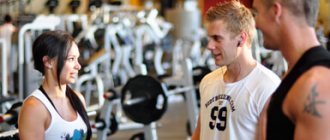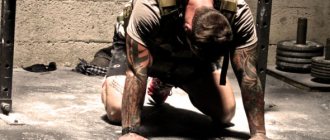CrossFit is a relatively new direction in sports, which is gaining more and more fans every day. For beginners, this program may seem completely incomprehensible and confusing. In fact, everything is not as difficult as it seems. The right CrossFit program for beginners is important, on the basis of which training will become easy, enjoyable and effective.
The principle of creating a training program
CrossFit is based on three areas that train skills necessary in everyday life. The initial level of training in this case guarantees better shape, general physical fitness and health than a high level with only one of these sports.
- Weightlifting Basics (W): Squats, deadlifts, presses, cleans and snatches.
These multi-joint exercises replicate movements that we regularly perform in everyday life. They develop muscle strength, speed and power, and also affect agility, coordination and accuracy.
- Gymnastics with your own weight (G): push-ups, including handstands, parallel bars, pull-ups, rope climbs with your legs or only on your hands, power lifts in rings, corner.
These exercises are the most difficult in CrossFit. They help develop extraordinary strength. Their areas of influence include flexibility, coordination, balance and agility.
Pull-ups are one of the main exercises in CrossFit, as they carry a very important vital function - the ability to lift your own weight. Moreover, if most men can do pull-ups on the horizontal bar or parallel bars at least 2-3 times, girls often cannot do even 1 time.
In this case, rubber loops (also called CrossFit loops), which are a 4.5 cm wide tourniquet folded in the shape of a double loop, will come to the rescue. They take on some of your weight. They are attached to the horizontal bar, stood on them and then pulled up.
You can adjust the degree of tension of the projectile (this determines how much weight they take on). Start with the tightest and then loosen.
- Aerobics has added cardio (M) to CrossFit: running, jumping rope, rowing and other exercises that can be classified as general physical fitness.
The most effective types are swimming up to 400 m, cycling, running, rowing up to 1500 m. In other words, the emphasis should be on sprint distances: 200, 400, 800 m. This type of exercise trains both cardiac and muscular endurance at the same time. Long-term cardio (more than 1 mile or 1.6 km) significantly reduces muscle performance.
This system fits into the concept of interval training. The most popular are Tabata intervals: 20 seconds of training, 10 seconds of rest, performed in 6-8 approaches. Medicine ball exercises are also effective: throws or team games, for example, pioneer ball (in CrossFit it is called hooverball).
Principles of standard training
- Intensity. The complexes are designed for a maximum of 30 minutes, but they must be performed at such a speed and without rest that the training can be equated to a 1.5 hour session.
- Competition with others and yourself. It is the feeling of competition that pushes us forward to new achievements, new weights and speed of performing the complex. Stock up on a stopwatch and opponents.
- At the forefront of everything is a methodology that cannot be deviated from, regardless of the level of training. It is possible to weaken the complex, or vice versa, to increase the load only due to the speed and weight of the projectiles.
- Constantly changing the training program. Unlike the gym, it is strictly contraindicated to work on one complex for a long time. Everything needs to be changed: both the exercises and the principles of programming.
What is the essence of the CrossFit effect? This training is aimed at solving 3 problems:
- Development of basic skills – there are 10 in total:
- sense of balance;
cardiorespiratory and muscular endurance;
- power;
- force;
- speed;
- flexibility;
- coordination;
- dexterity;
- accuracy.
- Preparing the body for unforeseen difficulties . In life, you have to run not only in the morning at the stadium, but also for a bus that suddenly arrived 2 minutes earlier than usual. Daily physical activity is spontaneous, so the body must be prepared not for a specific trained load, but for any sudden one. Therefore, in CrossFit there are many variations with different principles of construction, number of repetitions, and one complex cannot be done for 2 days in a row. CrossFit expands possibilities: each exercise or complex is constantly modified without causing addiction, and accordingly the body progresses in its development.
- Activation of all energy processes . The ability to switch from one energy supply to another in order to continue to perform at your best is very important. Cardio exercises play a decisive role here.
A person’s preparedness is assessed by these parameters, and, therefore, CrossFit training programs should be aimed at their development both through organic changes in the body and by optimizing the functioning of the nervous system.
AMRAP crossfit what does it give? Results, benefits
If the goal is to max out reps or rounds. It's important to keep track of how many reps or rounds you complete in a given workout. If you don't do this, you won't be able to track changes and improvements over time.
When we say AMRAP CrossFit workouts are a good way to track changes in your own fitness level, we're stating a fact. For example, you are doing an AMRAP workout today and can complete four rounds of exercises in 10 minutes. You can try the same workout a month later and try to do five rounds of exercise in the same period of time. If you reach your goal, your fitness level has improved.
It is important to remember that you are competing against yourself, not against anyone else. Ultimately, it's your workout. If you push yourself and do your best, it doesn't matter whether you complete one round or 10 rounds in a given period. Your goal is to improve your own performance, not worry about someone else's performance.
Indoor training programs
Taking into account the fact that one of the main goals of CrossFit is not to cause addiction in the body, back-to-back workouts should be radically different in terms of exercises and the principle of their implementation. A classic scheme has been developed:
Day 1: M - emphasis on CrossFit cardio training
Programs must be completed as quickly as possible.
- WOD The Stinger performed in 1 round.
- running – 1600 m;
- rest – 4 minutes;
- running – 1200 m;
- rest – 3 min.
- running – 800 m;
- rest – 2 minutes;
- running – 400 m;
- rest – 1 minute;
- running – 200 m.
- WOD Lira completed in 5 rounds.
- running – 1 km;
- burpees – 15 times.
- WOD Karabas also performed in 5 laps.
- pull-ups (with a heavy vest, belt or other weight of 12 kg) – 15 times;
- burpees – 15 times;
- lifting the body (sit-up) – 15 times;
- parallel bars (with a heavy vest, belt or other weight of 20 kg) – 15 times. This article will help you choose exercises on the uneven bars;
- press fold (join the feet and hands at the top) – 15 times.
Day 2: GW - the basis of gymnastics and weightlifting training
- WOD Fran is the first WOD that combines weightlifting (W) and gymnastics (G) foundations. It is built according to the ladder principle: 21 repetitions - 1 move, circle, 15 repetitions - 2, 9 repetitions - 3 circle. This number of times you need to perform two exercises in a row:
- thruster (squat with barbell release),
- pull-ups.
- WODRoy consists of 5 rounds that need to be completed in the minimum time.
- deadlift with a weight of 100 kg – 15 times;
- jumping onto a hill, box (60 cm) – 20 times;
- pull-ups – 25 times.
- WOD Jack involves a 20-minute high-speed approach for the maximum number of laps.
- Shvung barbell 52 kg bench press – 10 times;
- kettlebell swings 24 kg – 10 times;
- jumping onto a box, 60cm – 10 times.
- WOD Franco must be completed in 1 round in a minimum amount of time.
- emissions 60 kg – 10 times;
- power lift 60 kg on the chest – 10 times;
- Shvung press 60 kg – 10 times;
- deadlift with 60 kg – 10 times;
- kettlebell swings 24 kg – 10 times;
- lunges with 10 kg dumbbells – 10 times;
- burpee – 10 times;
- lifting the body – 10 times;
- jumping rope (double scrolling) – 10 times;
- emissions with a weight of 60 kg - 10 times.
Day 3: (cardio + gymnastics) MG.
- WOD Kelly consists of 5 rounds that must be completed as quickly as possible.
- running – 400 m;
- jumping onto a box 60cm – 30 times;
- throws a medicine ball weighing 9 kg – 30 times.
- WOD Nicole involves a maximum number of approaches in 20 minutes.
- running – 400 m;
- Pull-ups to the point of exhaustion.
- WOD Bradley – these are 10 circles that must be completed as quickly as possible, rest between them – 30 seconds.
- sprint – 100 meters;
- pull-ups – 10 times;
- sprint – 100 meters;
- burpees – 10 times.
Day 4: break.
Day 5: (gymnastics) G is one of the most difficult.
- WOD Weaver - this is 4 rounds for a while.
- pull-ups – 10 times;
- standard push-ups – 15 times;
- chest-to-bar pull-ups – 15 times;
- standard push-ups – 15 times;
- pull-ups with swinging – 20 times;
- standard push-ups – 15 times.
- WOD Ledesma must be performed for 20 minutes, maximum number of circles.
- handstand push-ups – 5 times;
- socks to rings – 10 times;
- taking a medicine ball weighing 9 kg on the chest – 10 times.
- WOD Karen - this is 1 round and only 1 exercise for a while.
- 150 throws of a medicine ball weighing 9 kg at a target at a height of 3 meters.
Day 6: (weightlifting + cardio) WM.
- WOD Nancy consists of 5 rounds, which should be performed against time.
- running – 400 m;
- squats with a barbell of 43 kg overhead – 15 times.
- WOD Abbot - this is 1 round for a while.
- running – 1600 km;
- lifting a 70 kg barbell on the chest and clean and jerk – 21 times;
- running – 800 m;
- lifting a 70 kg barbell on the chest and clean and jerk – 21 times;
- running – 1600 m.
Day 7: (gymnastics + weightlifting + cardio) GWM.
- WOD Rankel perform for 20 minutes, circle by circle.
- deadlift with a weight of 100 kg – 6 times;
- burpees with pull-ups – 7 times;
- kettlebell swings weighing 32 kg – 10 times;
- running – 200 m.
- WOD Badger - this is 3 laps in the minimum time.
- cleans 43 kg from the floor into squats – 30 times;
- pull-ups – 30 times;
- running – 800 m.
- WOD Daniel - this is 1 round, which must be completed as quickly as possible.
- pull-ups – 50 times;
- running – 400 m;
- throwing a barbell weighing 43 kg – 21 times;
- running – 800 m;
- throwing a barbell weighing 43 kg – 21 times;
- running – 400 m;
- pull-ups – 50 times.
Day 8: break.
Day 9: (weightlifting) W
All exercises must be completed as quickly as possible.
- WOD Randy Power snatch with a 35kg barbell, taken from the floor each time – 75 times;
- WOD Grace Clean & Jerk 60 kg – 30 reps;
- WOD Double Karen Throws a medicine ball weighing 9 kg at a target located at a height of 3 m - 300 times.
Day 10: (cardio + gymnastics) MG repeat day 3.
Day 11: (weightlifting + cardio + gymnastics) WMG.
- WOD Hortman perform in circles without stopping for 45 minutes.
- running – 800 m;
- squats – 80 times;
- exit to the rings – 80 times.
- WOD Rankel performed for a time.
- deadlift with a weight of 100 kg – 6 times;
- burpees with pull-ups – 7 times;
- kettlebell swings weighing 32 kg – 6 times;
- running – 200 m.
- WOD Badger - this is 3 rounds in the shortest possible time.
- lifting 43 kg on the chest – 30 times;
- pull-ups – 30 times;
- running – 800 m.
Necessary equipment
- Clothes should not restrict movement, so you should choose materials that stretch.
- The fabric should be light and breathable and absorb moisture.
- To avoid overheating, opt for a minimal suit: shorts and a T-shirt. It is especially important not to overload the heart area.
- Shoes – only sneakers. Some train in weightlifting machines designed for weightlifters. However, if the WOD includes running or jumping rope, then this option is canceled.
- Protective accessories will not hurt: for shins, special gloves, knee pads, a headband (to prevent sweat from running onto your face).
- With a heart rate monitor it is convenient to monitor the progress of your heart training; more details about the choice here. And for long runs in nature, use a running app;
- You can use a hypoxic mask to increase endurance.
CrossFit Specialization
On the one hand, you can say: “He who is everywhere is nowhere.” And indeed it is. A professional CrossFitter will never be able to overtake a marathon runner or squat more than a weightlifter, since the latter have a narrow specialization, they hone their skills in only one area. The specialization of CrossFit is the absence of any specialization.
And CrossFit competitions are held in a very interesting way: they take a variety of exercises - from squats with a barbell to walking on hands, because a real CrossFitter must be ready for any challenge. In our opinion, there is something rational here: in real life we will not squat 250 kg, but run at a very fast pace to the bus, lift a heavy bag, push a car - such everyday loads accompany us all our lives.
Types of loads in crossfit
When a CrossFit program is drawn up, 3 types of loads are taken into account:
M – aerobic exercise. Running, jumping rope, cycling.
G – gymnastics. Pull-ups, push-ups, in general - all exercises with your own weight.
W – work with weights. Squats, deadlifts, snatches, kettlebell swings, etc.
The CrossFit training program is designed taking into account that the types of loads should alternate as much as possible. For example, this week your 1st workout is aerobic, 2nd is aerobic with elements of gymnastics, 3rd is aerobic with elements of weightlifting. It is such alternations that allow you to develop overall functionality, since the body does not adapt to one type of load.
Types of rounds in CrossFit
CrossFitters value their time very much. The main attribute of any CrossFit gym is a clock, an interval timer. In CrossFit, concepts such as sets, rounds, intervals, and also:
AMRAP (ZKMBR) - finish as many rounds as possible in a certain amount of time. AMRAP 20 minutes is common.
EMOM – starts a new round at the beginning of every minute. That is, for example, if it says “EMOM 20 minutes (20 rounds). Each consists of: 3 squats, 3 cleans, 3 snatches.” We do all these 3 exercises without stopping. This, for example, took us 40 seconds, which means we have 20 seconds of rest before the start of the second minute. From the start of the second minute we must start making the second round. And so on, all 20 minutes.











